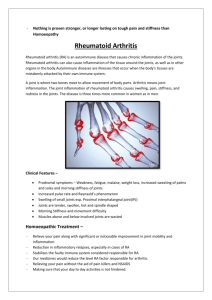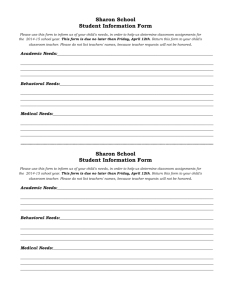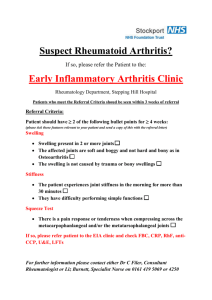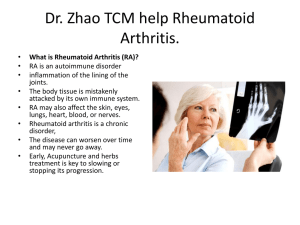INTERACTIVE CASE STUDY
advertisement
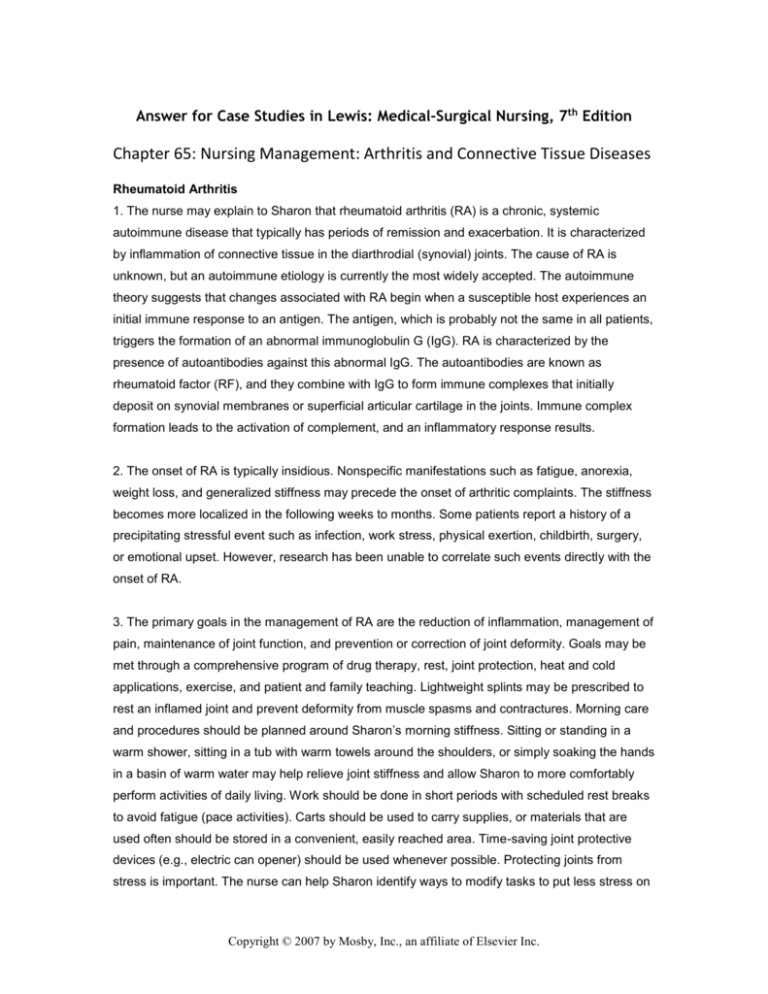
Answer for Case Studies in Lewis: Medical-Surgical Nursing, 7th Edition Chapter 65: Nursing Management: Arthritis and Connective Tissue Diseases Rheumatoid Arthritis 1. The nurse may explain to Sharon that rheumatoid arthritis (RA) is a chronic, systemic autoimmune disease that typically has periods of remission and exacerbation. It is characterized by inflammation of connective tissue in the diarthrodial (synovial) joints. The cause of RA is unknown, but an autoimmune etiology is currently the most widely accepted. The autoimmune theory suggests that changes associated with RA begin when a susceptible host experiences an initial immune response to an antigen. The antigen, which is probably not the same in all patients, triggers the formation of an abnormal immunoglobulin G (IgG). RA is characterized by the presence of autoantibodies against this abnormal IgG. The autoantibodies are known as rheumatoid factor (RF), and they combine with IgG to form immune complexes that initially deposit on synovial membranes or superficial articular cartilage in the joints. Immune complex formation leads to the activation of complement, and an inflammatory response results. 2. The onset of RA is typically insidious. Nonspecific manifestations such as fatigue, anorexia, weight loss, and generalized stiffness may precede the onset of arthritic complaints. The stiffness becomes more localized in the following weeks to months. Some patients report a history of a precipitating stressful event such as infection, work stress, physical exertion, childbirth, surgery, or emotional upset. However, research has been unable to correlate such events directly with the onset of RA. 3. The primary goals in the management of RA are the reduction of inflammation, management of pain, maintenance of joint function, and prevention or correction of joint deformity. Goals may be met through a comprehensive program of drug therapy, rest, joint protection, heat and cold applications, exercise, and patient and family teaching. Lightweight splints may be prescribed to rest an inflamed joint and prevent deformity from muscle spasms and contractures. Morning care and procedures should be planned around Sharon’s morning stiffness. Sitting or standing in a warm shower, sitting in a tub with warm towels around the shoulders, or simply soaking the hands in a basin of warm water may help relieve joint stiffness and allow Sharon to more comfortably perform activities of daily living. Work should be done in short periods with scheduled rest breaks to avoid fatigue (pace activities). Carts should be used to carry supplies, or materials that are used often should be stored in a convenient, easily reached area. Time-saving joint protective devices (e.g., electric can opener) should be used whenever possible. Protecting joints from stress is important. The nurse can help Sharon identify ways to modify tasks to put less stress on Copyright © 2007 by Mosby, Inc., an affiliate of Elsevier Inc. Answer Guidelines for Case Studies in Textbook 65-2 her joints during routine activities. Wearing shoes with Velcro fasteners and clothing with buttons or a zipper down the front instead of the back makes dressing easier. A cane or a walker offers support and relief of pain when walking. A platform wheeled walker further minimizes strain on the small joints of the hands and wrists. 4. The nurse should explain to Sharon that alternating scheduled rest periods with activity throughout the day helps relieve fatigue and pain. The nurse should help Sharon identify ways to modify daily activities to avoid overexertion that can lead to fatigue and an exacerbation of disease activity. Good body alignment while resting can be maintained through use of a firm mattress or bed board. Positions of extension should be encouraged, and positions of flexion should be avoided. Lying prone for half an hour twice daily should be recommended to Sharon. To decrease the risk of joint contracture, pillows should never be placed under the knees. A small, flat pillow may be used under the head and shoulders. 5. Nursing diagnoses: fatigue, impaired physical mobility, disturbed body image, chronic pain Collaborative problems: flexion contractures, hand deformities, side effects of corticosteroids Copyright © 2007 by Mosby, Inc., an affiliate of Elsevier Inc.
